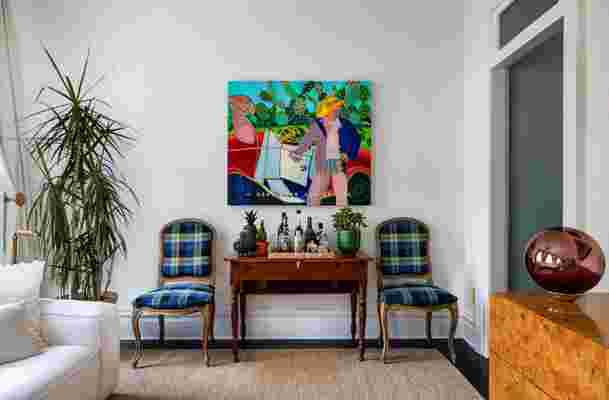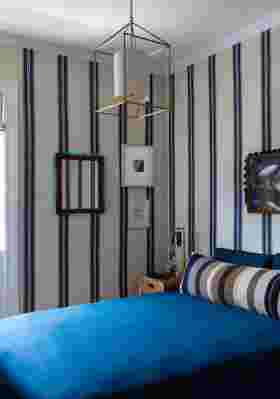When stepping inside Carlos Huber's West Village apartment, the first thing one notices is that it smells divine. Like petrichor and vetiver; it's earthy, fresh, and woody—"like nighttime in a tropical garden in 1970s Acapulco," he says. The lush green jungle plants, sisal rug, playful color palette, and cameos of Mexican textiles in the living room do well to complete the mood; they're subtle references to his hometown of Mexico City .

Two chairs from the estate of Mexican designer Arturo Pani flank a bar cart Huber found on the street in New York almost a decade back. Above is a painting by artist Ana Segovia. "I love it for the colors, and that it has a vague nod to Mexico with the cactus and hats, but it's not obvious." A Milo Baughman–esque burled wood credenza runs along the wall beneath a mirrored orb, which is considered to be traditional folk art in Mexico.
After he viewed over 30 apartments around New York , the two-bedroom prewar apartment was the perfect find for the architect and perfumer. And as luck would have it, it was just down the block from his prior home on Patchin Place. "I kind of wanted to stay in the West Village, but I was really aware that if something came up that was a beautiful apartment, it would make me very happy. Something that has this kind of magic, you know?" he says, gesturing to rays of afternoon light hitting the couch.
Built in 1889, the apartment hadn't been renovated since the 1960s and was faithful to its original layout, which he loved, having studied architecture with a concentration in historic preservation. A good-sized nook off the kitchen made for the perfect home office for his boutique fragrance company, Arquiste (the name is a clever amalgamation of the Spanish and French words for "architecture" and "history"), which is responsible for the luscious scent permeating the railroad space. "I love the longitudinal layout; I like the compartmentalization of space." Sure, the bedrooms are small, but he prefers it that way: "I don't need a big master suite—I'd rather actually spend my day in the living room, and have that be a cocoon."

In the master bedroom, Huber wanted to capture the feel of something tented and immersive. Fabric wallpaper from Schumacher line the walls and a striped lumbar pillow from friend Josh Greene rests on the bed atop a blue Belgian linen spread. Atop the headboard is a find from one of Paris's brocantes : a painting of comic book character Corto Maltese, whom Huber loved as a child.
The ultimate resource for design industry professionals, brought to you by the editors of Architectural Digest

He first found the space in March 2018, and moved in just over a year later once the renovation was complete. The previous owner had lived here for over 40 years, but didn't do much aside from restore the woodwork around the windows and door surrounds. "It was crisp; very nice and polished, but otherwise it was a bit of a mess," he says. So he set to work updating and preserving the historic space, removing the laminate tiles to reveal wooden floors, which he resanded, finished, and stained a Japanese black.
As he'd had a lot of time to think about how he wanted it to look, the decor came together in quick fashion. There are nods to his Mexican heritage and his love of French classical architecture and antiques peppered throughout, but it also feels clean and modern. "I think it's better to decorate as you go, but to be honest I'm very big on just having it done. It's the architect in me— This is the plan and we stick to it ," he says, laughing.
So, is he finished? "I think so. Maybe things will move around, or one day I'll want to do new curtains or something like that. If [my partner] Andrew moves in, maybe that's something, to make it represent him as well."
